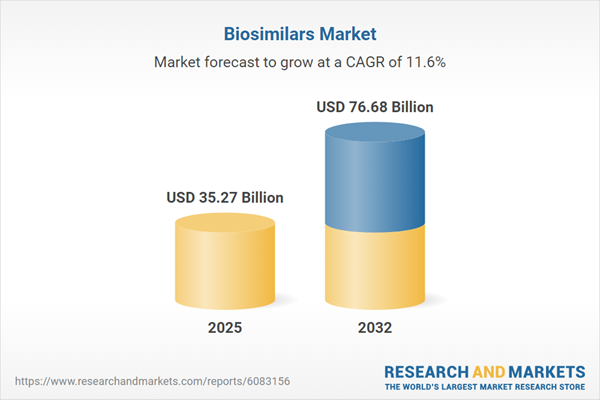Speak directly to the analyst to clarify any post sales queries you may have.
The global biosimilars market is at a pivotal phase, marked by innovation, regulatory evolution, and growing interest from healthcare stakeholders. This comprehensive report provides in-depth insights tailored to senior decision-makers seeking to evaluate opportunities and risks within the expanding biosimilars landscape.
Market Snapshot: Growth and Competitive Landscape in the Biosimilars Market
The biosimilars market grew from USD 31.83 billion in 2024 to USD 35.27 billion in 2025, maintaining an impressive compound annual growth rate (CAGR) of 11.61%. Forecasts indicate the sector will reach USD 76.68 billion by 2032. This sustained advancement is driven by a steady pipeline of biosimilar applicants, the expiration of exclusivity periods for key biologic patents, and accelerating adoption across diverse therapeutic areas. Market players are responding by investing in advanced manufacturing, forging strategic alliances, and developing new commercialization models to enhance accessibility and cost containment across global healthcare systems.
Scope & Segmentation: Mapping the Biosimilars Market
This report offers an extensive segmentation analysis, enabling a granular view of the biosimilars ecosystem across product categories, indications, administration methods, user channels, and regions.
- Product Types: Erythropoietin, Follitropin, Granulocyte-Colony Stimulating Factor (G-CSF), Human Growth Hormone, Insulin, Interferons, Monoclonal Antibodies (mAbs)
- Indications: Autoimmune Diseases, Blood Disorders, Diabetes, Growth Hormone Deficiency, Infectious Diseases, Oncology
- Administration Routes: Intramuscular, Intravenous, Subcutaneous
- End Users: Clinics, Homecare, Hospitals
- Regions & Sub-Regions: Americas (United States, Canada, Mexico, Brazil, Argentina, Chile, Colombia, Peru), Europe, Middle East & Africa (United Kingdom, Germany, France, Russia, Italy, Spain, Netherlands, Sweden, Poland, Switzerland, United Arab Emirates, Saudi Arabia, Qatar, Turkey, Israel, South Africa, Nigeria, Egypt, Kenya), Asia-Pacific (China, India, Japan, Australia, South Korea, Indonesia, Thailand, Malaysia, Singapore, Taiwan)
- Key Industry Players: Alvotech S.A, Amgen Inc., Apotex Inc., Biocon Limited, BioFactura, Inc., Biogen Inc., Boehringer Ingelheim International GmbH, Catalent, Inc, Celltrion Healthcare Co.,Ltd., Coherus BioSciences, Dr. Reddy's Laboratories Limited, Eden Biologics, Inc., F. Hoffmann-La Roche AG, Fresenius Kabi, Innovent Biologics, Inc., Intas Pharmaceuticals Ltd., Kashiv BioSciences, LLC., Merck KGaA, NeuClone, Nippon Kayaku Co., Ltd., Novartis AG, Panacea Biotec Limited, Pfizer Inc., Samsung Bioepis Co., Ltd., Sanofi S.A., Shanghai Henlius Biotech, Inc., Teva Pharmaceutical Industries Ltd., Thermo Fisher Scientific, Inc., Apobiologix
Biosimilars Market: Key Takeaways for Strategy and Decision-Making
- Market expansion is closely tied to advances in manufacturing efficiency and the scalability of expression systems, supporting comparative quality to reference biologics.
- Regulatory harmonization in major regions simplifies international launches and supports consistent pharmacovigilance, easing barriers for global market entry.
- Strategic alliances across development and commercialization enable reduced time-to-market and risk mitigation amid increasing competition and complex supply chains.
- Shifts in payer and provider perceptions are facilitating greater acceptance of biosimilars, especially as robust real-world evidence and educational initiatives gain traction.
- Companies are diversifying their portfolios, targeting high-value therapeutic areas such as oncology and diabetes, supported by the adoption of state-of-the-art manufacturing technologies.
- Segment-specific product design—including prefilled delivery devices and adaptable administration options—improves patient adherence and supports homecare adoption.
Impact of 2025 US Tariffs on Supply Chains and Pricing
The introduction of US tariffs in 2025 is reshaping procurement and sourcing strategies for biosimilar manufacturers. Companies dependent on imported raw materials or intermediates face increased input costs, prompting a shift toward domestic sourcing and revised contractual agreements to mitigate volatility. Manufacturers are emphasizing operational agility through procurement adaptations, and proactive stakeholder engagement is critical to preserving supply chain resilience, cost control, and market competitiveness within the biosimilars sector.
Methodology & Data Sources
This report combines primary interviews with senior industry executives and regulatory experts alongside secondary research from peer-reviewed journals, patent filings, and proprietary transaction databases. Findings are validated through methodological audits, interview triangulation, and in-depth case study analyses to ensure accuracy and actionable insights for strategic planning.
Why This Report Matters for Senior Decision-Makers
- Provides a comprehensive outlook across segmentation, regional trends, and competitive positioning to inform strategic investments or market entry decisions.
- Equips leaders with scenario analyses for navigating policy changes, supply chain challenges, and evolving regulatory frameworks essential to the biosimilars market.
- Supports data-driven portfolio diversification and risk management by highlighting opportunities in emerging therapeutic areas and geographic markets.
Conclusion
This analysis empowers stakeholders to navigate the evolving biosimilars environment with data-backed clarity. By leveraging segmentation insights and scenario planning, organizations can secure sustainable growth and competitive differentiation in the global biosimilars market.
Table of Contents
3. Executive Summary
4. Market Overview
7. Cumulative Impact of Artificial Intelligence 2025
Companies Mentioned
The companies profiled in this Biosimilars market report include:- Alvotech S.A
- Amgen Inc.
- Apotex Inc.
- Biocon Limited
- BioFactura, Inc.
- Biogen Inc.
- Boehringer Ingelheim International GmbH
- Catalent, Inc
- Celltrion Healthcare Co.,Ltd.
- Coherus BioSciences
- Dr. Reddy's Laboratories Limited
- Eden Biologics, Inc.
- F. Hoffmann-La Roche AG
- Fresenius Kabi
- Innovent Biologics, Inc.
- Intas Pharmaceuticals Ltd.
- Kashiv BioSciences, LLC.
- Merck KGaA
- NeuClone
- Nippon Kayaku Co., Ltd.
- Novartis AG
- Panacea Biotec Limited
- Pfizer Inc.
- Samsung Bioepis Co., Ltd.
- Sanofi S.A.
- Shanghai Henlius Biotech, Inc.
- Teva Pharmaceutical Industries Ltd.
- Thermo Fisher Scientific, Inc.
- Apobiologix
Table Information
| Report Attribute | Details |
|---|---|
| No. of Pages | 192 |
| Published | November 2025 |
| Forecast Period | 2025 - 2032 |
| Estimated Market Value ( USD | $ 35.27 Billion |
| Forecasted Market Value ( USD | $ 76.68 Billion |
| Compound Annual Growth Rate | 11.6% |
| Regions Covered | Global |
| No. of Companies Mentioned | 30 |









